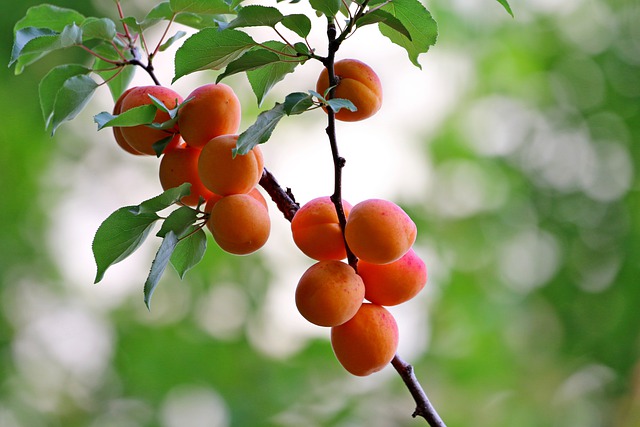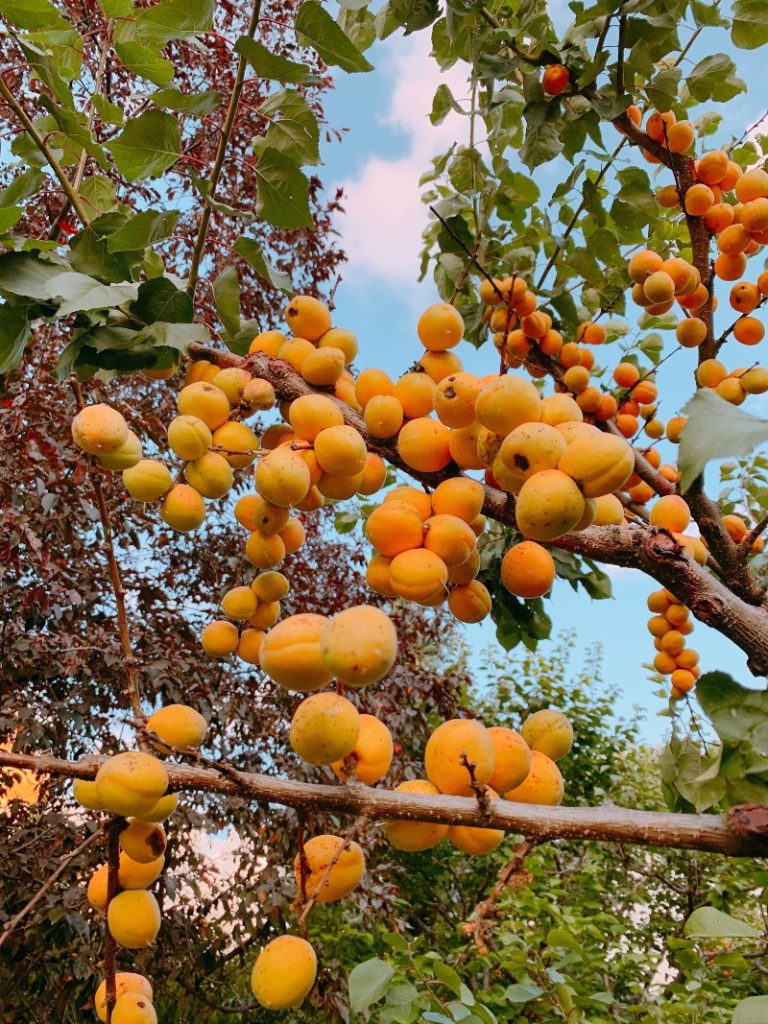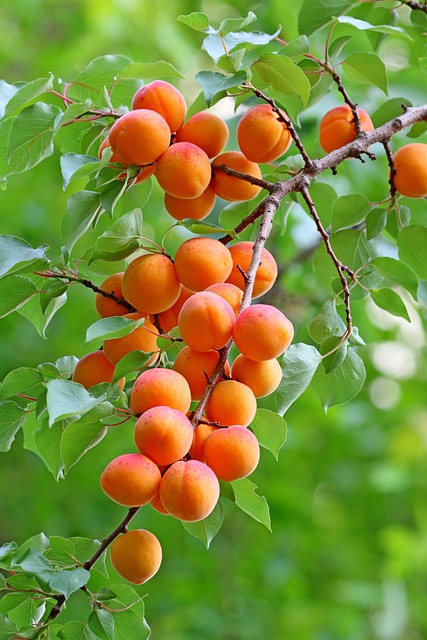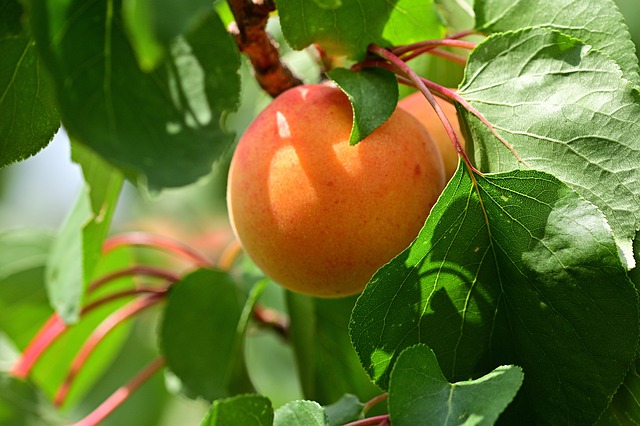How Big Does An Apricot Tree Grow?

A standard-sized tree can grow to a height and width of 20 to 25 feet. Semi-dwarfs can grow to a height and spread of 12 to 18 feet, while dwarfs are much smaller, reaching a maximum height and spread of 5 to 8 feet. These trees are small enough for a home orchard, making them ideal for beginners. Apricot trees are diminutive in stature but mighty in fruit production.
Your apricot tree blooms in early spring, making it one of the season’s first bloomers. Seeing one of your apricot trees bloom is a wonderful feeling. There is nothing more satisfying to a home gardener than picking their beautiful fruit. A few varieties can be harvested as early as June, while others can be harvested as late as August. Extending your apricot growing season is as simple as planting two different varieties.
For gardeners with limited space, apricot trees are ideal because they can be grown successfully in containers. Because they prefer regular watering with well-drained soil, you have more control over the soil moisture.
Table of Contents
Growth Rate
This tree grows rapidly, increasing in height by more than 24″ each year.
20 Homegrown Apricot Tree Varieties to Try Out This Summer

Autumn Glo Apricot Tree
- Mature Height — 12-15 Feet
- Mature Spread — 12-15 Feet
This apricot variety is best suited to USDA Hardiness Zones 7 and 8. To a temperature of 28 degrees Fahrenheit, this tree is extremely hardy. Some Autumn Glo dwarf apricot tree varieties can grow up to 18 feet tall. These trees can be planted in a 4-in-1 or 3-in-1 fashion. In order to reap the benefits of longer harvest times and save space, you can implement this strategy.
Blenheim Apricot
- Mature Height — 15-20 Feet
- Mature Spread — 5-20 Feet
You don’t have to eat the apricots fresh, dried, or canned to enjoy the flavor and aroma of Blenheim apricots. In the spring, their fragrant pink or white blossoms add to the beauty of the landscape. Round and compact are the characteristics of their lifestyle. It doesn’t change as they get older.
Trees and other permanent structures should be kept at least 15 to 20 feet away from Blenheim. This species stands 15-20 feet tall and matures with a 5-20 feet wingspan.
Brittany Gold Apricot Tree
- Mature Height — 12-15 Feet
- Mature Spread — 12-15 Feet
The Brittany Gold is one of the larger apricot trees, and it will grow densely and have a tendency to have a large canopy. In order to keep this apricot tree in the proportions you prefer, it is best to keep a distance of between six and ten feet from it. Because it tends to produce a lot of dense clusters of fruit, it can be either beneficial or detrimental, depending on the climate. Thinning is usually a good idea.
Canadian White Blenheim Apricot Tree
- Mature Height — 12-15 Feet
- Mature Spread — 10-15 Feet
The sweetest apricots are usually Canadian White Blenheim apricots grown in Canada. They have a lot of juice, but the flesh is firm and white. Whether eaten fresh or dried, frozen or preserved, they have a distinctive flavor and aroma. Only a very small percentage of Canada’s White Blenheim apricots can be stored in a freezer for future use.
Trees and other permanent structures must be kept at least 15 feet away from Canadian White Blenheim apricots. Their final height and span will be between 15 and 20 feet in about ten years.
Chinese Apricot Tree
- Mature Height — 15-20 Feet
Juicy and mildly sweet, the fruit it produces is one of its most appealing by-products. Even though the Chinese Apricot tree is self-pollinating, you may still want to plant some pollinating partners to increase your harvest size even further. This is a semidwarf tree with an average height of about 15 feet.
Semidwarf apricots are found in China, and this one is no exception. There is a minimum of 8-10 feet between the tree and any patios, water lines, or sewer pipes if you want it to reach its full potential of 15 to 20 feet tall. A tree’s height should be between 6 and 10 feet for orchard use, but it can be pruned to any desired size.
Flavorella Plumcot
- Mature Height — 10-18 Feet
- Mature Spread — 15-18 Feet
In comparison to other plum varieties, flavorella plumcot’s fruit is medium-sized. Despite this, it doesn’t appear to be a plum from the outside. Firm and juicy, these fruits are highly sought after for their appearance and scent.
The flavorella plumcot tree can grow to between 10 and 18 feet in terms of height. For mature trees, they can reach 15 to 18 feet. Flavorella plumcot trees can be planted in several ways. One option is to plant the trees 20 feet apart, starting from the center of each one.
This can be accomplished by spacing each one five feet apart from its neighbor. Using this technique, each tree’s canopy will grow together to provide additional privacy or shade. Pruning the tips of a tree in the summer can help keep its height and width in check if you notice that it’s becoming too large.
Golden Kist Apricot Tree
- Mature Height — 12-18 Feet
For the most part, these trees reach heights of between 15 and 25 feet. Although dwarf and semidwarf types are available, they don’t grow as tall. The eight-foot-tall dwarf varieties are ideal for home growers who intend to keep them in a pot. There are semidwarf trees, which grow to about 15 feet in height.
An apricot tree that bears gold kists isn’t very wide-ranging. It’s not uncommon for them to reach a mature width of 10 to 20 feet.
Because the spread of a Gold Kist apricot tree usually does not grow more than 10 to 20 feet across, it may be possible to grow multiple fruits, ornamental, or other types of trees in your yard with this particular variety. The appropriate distance between apricot trees should be at least 20 feet. The same holds for other types of trees. The spread of other trees should be considered if you’re planting other trees. If you don’t prune your other trees, the apricot tree might not get the sunlight it needs.
Golden Sweet Apricot Tree

- Mature Height — 12-18 Feet
It’s no secret that the Golden Sweet Apricot Tree is a popular ornamental apricot tree. With heart-shaped leaves, it can reach a height of 15 feet. There is a large mushroom-like shape to the canopy, which provides both shade and a distinct appearance.
This tree is a great option for gardeners with an eye for style because of these features.
North American gardeners are in for a treat. This apricot has been specifically bred to thrive in these types of conditions. It thrives in USDA plant hardiness zones 5-8, making it suitable for planting in nearly every state.
Give the Golden Sweet Apricot Tree about the same amount of space as its final canopy size if you want to adhere to the golden rule. This means that this tree will need somewhere between 15 and 20 feet of room.
Harglow Apricot Tree
- Mature Height — 12-15 Feet
- Mature Spread — 12-15 Feet
Smaller than the average apricot tree, the Harglow apricot tree can only grow to a height of 12 feet. It’s a hardy tree that’s easy to grow because it’s resistant to brown rot and some types of bacterial cankers.
It can tolerate temperatures as low as -25°F (-31.7°C) and is relatively resistant to pests and insects. A single tree can produce up to 50 pounds of fruit in a single season.
Harglow apricots are medium-sized and bright orange with a firm, sweet flesh.
Because of its small stature, the Harglow apricot tree is bests when placed in a small area. Dwarf apricot trees typically grow to 12 to 15 feet, so this one fits that description (as opposed to full-sized apricot trees, which can reach up to 25 feet).
Space your Harglow apricot trees between 12 and 15 feet apart if you decide to plant more than one. This is close enough for cross-pollination to be beneficial while allowing each tree sufficient room to flourish.
Harcot Apricot
- Mature Height — 15-25 Feet
- Mature Spread — 15-25 Feet
The Harcot variety of apricot trees is a bit of a late bloomer, producing fruit in the middle of the summer. The apricot must be picked at the right time to ensure that the taste and texture are of the highest quality. These medium-sized fruits have a consistent orange color with a red blush, which indicates that they are ripe and ready to be harvested.
There won’t be a significant harvest until the Harcot Apricot is between 3 and 5 years old.
The Harcot Apricot tree, one of the larger ones, can reach a height and width of 15 to 25 feet. Planting it close to the patio, sewer lines, and water piping is recommended. When it comes to thick canopies, it’s best to thin them out.
Hunza Apricot Tree
- Mature Height — 10-15 Feet
- Mature Spread — 10-15 Feet
In the foothills of the Himalayas, Hunza apricot trees can be found growing at elevations between 1,200 and 2,900 meters. In the winter, they can withstand temperatures of -22°F (-30°Celsius) and 105°F(40°Celsius) in the summer, making them extremely hardy trees. They can withstand being buried in the snow and the heat of the summer without succumbing.
Hunza apricots should be spaced at least ten to twenty-five feet (3 to five meters) apart from other trees and structures that will remain in place. In Pakistan, they reach 10 to 15 feet (3 to 5 meters) and a mature length of 10 to 15 feet. In North America, milder winters and increased irrigation may allow them to grow larger.
Katy Apricot Tree
- Mature Height — 15-18 Feet
- Mature Spread — 15-18 Feet
The Katy Apricot thrives best in growing zones 7 through 10, whereas most apricot trees thrive in zones 5 through 8. It thrives in the southern states, where gardeners of all stripes flock to it in droves.
There should be plenty of room for the tree to grow, as its height and spread are both between 15 and 18 feet at their full height. You don’t even need a chainsaw to trim this one down to a manageable size to make matters even better. For orchards, a height of six to ten feet is generally recommended. Aside from aiding in disease prevention, reducing the tree’s height facilitates fruit harvest.
Moorpark Apricot Tree
- Mature Height — 12-20 Feet
- Mature Spread — 12-15 Feet
Thanks to their high frost and rain resistance, Moorpark apricot trees can tolerate a wide range of climates. From growing zones five to eight, it performs well. Its late-blooming period protects it from late frosts in colder climates, allowing it to thrive.
These trees can grow to be quite large, and they do so rapidly. It can grow to a height of 15 to 20 feet and a width of 20 feet when fully mature. Each year, the tree will grow by about 24 inches in height.
Plant these trees at least 15 feet apart for the best results.
Patterson Apricot Tree
- Mature Height — 10-15 Feet
- Mature Spread — 15-30 Feet
Zones 4-9. Patterson apricots do well. If they have a cold period to set their fruit, they perform better than other varieties. Ideally, this period should last about four months. Your Patterson apricot tree will thrive if you live in an area where temperatures consistently fall below 7 C (45 F) for at least 700 to 1,000 hours.
If you live in a colder climate, be on the lookout for frost damage on apricot trees. Other varieties are better suited to regions that experience sudden and unexpected cold snaps.
The Patterson apricot tree can reach 15 to 30 feet, depending on the variety. The canopy’s width varies from 10 to 15 feet. Plant them at least 10 feet apart, if not more, for this reason.
Perfection Apricot Tree
- Mature Height — 6-8 Feet
- Mature Spread — 6-8 Feet
Zones 4 through 8 can grow the Perfection apricot. It is well-known for its high level of cold resistance. If the spring has been unusually cold and there have been late frosts, this plant may not be able to bloom at its full potential.
Smaller-than-average apricot trees are a sure sign of perfection. These trees can grow to 6ft with a diameter of up to 8ft when they’re fully grown. Plant them at least six feet apart from any other structures or trees as a general rule of thumb.
Puget Gold Apricot Tree
- Mature Height — 10-15 Feet
- Mature Spread — 10-15 Feet
Among America’s favorite fruiting trees is the Puget Gold Apricot Tree, native to the Pacific Northwest. A large part of this is because it thrives in zones 5 through 9. Because of this, nearly every state in the country has some areas where these trees can be grown happily.
Giant apricot trees have been reported to grow to heights between 10 and 15 feet, with some trees growing to heights significantly greater than that. The dwarf varieties are much smaller than the standard varieties.
Allow plenty of space between each of these trees to plant them. They will have enough space to produce delicious fruit without competing with the apricot trees in their immediate vicinity if they are allowed to grow up to 16 feet apart from their neighbors.
Royal Rosa Apricot Tree
- Mature Height — 15-18 Feet
- Mature Spread — 15-18 Feet
When left unpruned, the Royal Rosa apricot tree can reach 20 to 25 feet, but most growers prefer to keep it at or below that. Unlike many other apricot varieties, this one is disease resistant, making it a simple tree to grow. Because the pit is not firmly attached to the flesh, this fruit is a freestone type.
Zones 7 through 9 are suitable for planting the Royal Rosa Apricot Tree. So that the trees aren’t damaged by the cold, it’s placed in areas that don’t get too hot and have acceptable winter temperatures.
To keep them smaller, it is common practice to prune these apricot trees, which can grow to a height of 20′ to 25′ in the wild. This makes harvesting the fruit and caring for the tree much easier. Pruning the tree to a height of 10 to 15 feet is ideal if you plan on covering it with bird netting. If you prune the trees to their proper size, they should be spaced about 8 to 10 feet apart when planting. As a rule, if you leave them as they are, they should be at least 15 feet apart from the tree center.
Tilton Apricot Tree
- Mature Height — 15-25 Feet
- Mature Spread — 12-20 Feet
Originally, the Tilton apricot tree was popular because of its ability to withstand freezing temperatures. It’s too hot for this tree in Zone 10 and Zone 11.
However, it can be grown in zones 6 through 8 with ease. It is possible to grow Tilton apricots in some areas of zone 9. It can be grown in areas of zone 9 that have late frosts.
Tilton apricot trees are medium-sized, between 15′ and 25′ tall and 15′ to 20′ wide. Because of their proximity to areas like water pipes and drainage systems (such as driveways), they should be planted far from these areas. Plant them between 8 and 10 feet away. The trees should be spaced at least 20 feet apart.
Tomcot Apricot Tree
- Mature Height — 12-15 Feet
- Mature Spread — 12-15 Feet
In regions from five to nine, the Tomcot apricot can thrive. Due to the increased risk of bacterial canker in excessively wet areas, it thrives in colder climates.
At maturity, the Tomcot apricot tree can grow to 15 to 25 feet. Trees should be spaced 12-15 feet apart. Healthy growth and cross-pollination can be encouraged with this amount of space.
Wenatchee Apricot Tree
- Mature Height — 12-18 Feet
- Mature Spread — 15-20 Feet
The Wenatchee apricot tree is a medium-sized tree with a high fruit yield and good frost and moisture resistance. Its quick time to fruit is one of its most notable features. Even other apricot varieties, such as the Wenatchee, have not been known to bear fruit in their first year, but the Wenatchee does.
There is a delicious firmness to the flesh of this large yellow fruit. SemidwarfLike the Wenatchee apricot, Semidwarf trees are common in the Pacific Northwest. When fully grown, its height ranges from 12 to 18 feet, and it has numerous, widely spaced branches. Plant the tree in a location where the soil drains well. Some gardeners can better drain the soil in a raised garden bed.
Apricot Tree Care and Growing Instructions

Nutrients and Water
Each week, thoroughly water the newly planted apricot tree. Once you notice healthy new growth, you can gradually reduce the frequency of your watering sessions. Mature apricot trees require approximately one inch of water every ten days, so if they aren’t receiving that amount from rain, provide additional water to your tree.
Fertilize your apricot trees only once during their first year. Indeed, wait until your trees begin bearing fruit before fertilizing them. Fertilize them with a high-nitrogen fertilizer or a general fruit tree fertilizer in the spring after the buds begin to grow. Avoid fertilizing after July 1, as the trees’ growth should begin to slow in preparation for winter.
Pollination
Having just one apricot tree doesn’t mean that you won’t get a harvest, but having more than one variety of apricot trees will yield more fruit. Bees and other nectar-loving insects primarily pollinate the tree. Pollination can be encouraged around your apricot trees by planting pollinator-friendly flowers in the vicinity of the trees.
Pruning
When the tree is still dormant in the spring, do your pruning. First, remove any branches that are diseased or dead and those that rub together. A quarter-inch cut away from the bud is the ideal distance to prune. After that, thin out the branches to create a more open structure that lets more light and air into the tree. Structural balance is best achieved with three to five main scaffolding branches wrapping around the tree’s trunk.
Diseases, Pests, and Other Animals
If you have apricot trees, you may be at risk for fungal diseases, such as brown rot. Keep your tree well-pruned and clean up any debris around the trunk to avoid these issues. An extension agent from your county can give you an overview of the most prevalent diseases in your area, as well as the best methods for dealing with them.
You should be on the lookout for aphids and other insects that may be damaging your trees, such as Japanese beetles and leafrollers. Horticultural spray and general-purpose insecticides are among the methods of control. Pollinator-friendly flowers can help attract beneficial insects, such as ladybugs, which eat aphids.
Your fruit trees may be attractive to rats and squirrels, who may try to get their hands on them. To keep them away, hang fluttering streamers from the tree. To keep these rodents out, consider installing a metal collar around the tree’s trunk.
Harvesting
You can expect your apricot trees to bear fruit three to five years after planting. Wait until the apricots are ripe and juicy on the tree before picking them, as they don’t ripen after they are picked like some other fruits. The apricots should be able to be removed from their stems with ease. According to the variety of your tree, apricots can be harvested from June through August.
To produce fruit, Light Apricot trees need a lot of sunlight. They should be planted in an area that receives at least three hours of sunlight each day, especially if the trees are still young and vulnerable to shade from other structures like walls and fences.
Temperature
Although most apricot trees are hardy to temperatures of -40°F (-40°C), the flowers can be damaged by late frosts. If you live in an area prone to late frosts, you’ll need to take precautionary measures.
Polyurethane or horticultural fleece can insulate the tree’s flowers from the cold, while the canes keep the fabric from touching the tree itself. For pollination and sunlight to reach the foliage, the fabric must be removed during the day. Planting apricot trees on higher ground will help protect them from frost, or you can look for hardier varieties of apricot trees that do better in colder climates.
Apricot trees thrive in regions with mild winters and hot summers, so they can be found throughout much of the western United States.

